Our Spiritual Journey ...
... and the Ox Herding Pictures
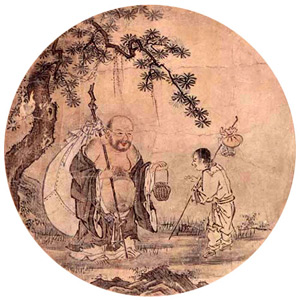
The Inner Journey
Many people today have a vague feeling of being lost or a
longing for something that is missing in their life. We may
know there is something missing, we may long for something
better, yet we just don't know what to do about it.
Fortunately, we have each been given an Inner Light, a Spirit of Guidance,
which is constantly available to provide calm guidance and
peaceful insight in each moment of our journey through life.
We just need to discover, and then follow, this inner source
of peace and wisdom. This process of discovery and
embodiment is often called the inner journey, or the
spiritual journey.
The inner journey is often recognized as having two
major aspects: first, the discovery of an inner source of calm and
serenity, and secondly the discovery of an inner source of
guidance and insight. Just as the calm, still depths of the
ocean are free of the turbulence seen on the surface, so too
are the depths of the heart calm and still, free of the
turbulence and chatter of daily life. When we have finally
entered the calm depths of the heart, we find that these
same calm depths are the home of wisdom and understanding.
We can discover the inner peace and understanding which
are our birthright if we are willing to put in the effort to
discover the calm inner guidance, a task which is often
accomplished through concentration, contemplation and
meditation. In doing so, we move beyond the distress and limitations caused by
our old ways of excessive self-concern, past conditioning and habitual
responses. When we abide in the inner calm and respond to the
needs of the present moment with beneficent
qualities such as loving-kindness, compassion, generosity
and tolerance, life is filled with joyful satisfaction.
Unfortunately, many of us respond to the challenges of
daily life in a rather predictable, habitual knee-jerk manner which
arises out of our past experiences, past opinions and past
preferences, rather than responding from the depths of the heart
to the present situation. Whenever we fail to respond to the challenges of the present moment
in a manner which is firmly founded upon clear understanding
of the present situation and the
calm guidance of the
inner depths of the heart, we're likely to feel a sense
of discontent or dissatisfaction.
The Inner Light, the Spirit of Guidance, in the ever-calm innermost
depths of the heart continually
urges us toward
beneficent traits such as loving-kindness, generosity,
tolerance, compassion, sympathy and forgiveness, and our
repeated expression of such qualities is crucial for our own
happiness and satisfaction in life. In fact, whenever we
fail to respond to those around us in a calm and peaceful manner which is
consistent with qualities such as loving-kindness, generosity,
tolerance, compassion, sympathy and forgiveness, our own
peace and satisfaction are greatly diminished.
It takes practice, often called spiritual practice, to
bring forth the calm and beneficent inner qualities in the midst of
turmoil and conflicts in daily life. Spiritual practices are
tools to help us bring forth these beneficent qualities and
let our unsatisfactory habits fall away.
An Overview of the Journey
Those who embark on the inner journey of spiritual
practice often have
fundamental questions such as:
Where does this spiritual path lead?
Where am I on the
path?
Fortunately for us, there are many signs and guideposts
along the way which have been provided by the prophets,
great teachers and fellow travellers to help
us answer such questions. The scriptures provide us
with means to calibrate our moral compass, and provide
suggestions of how to lead a good life, yet they generally
provide little guidance to help us understand with greater clarity where we are
headed and where we currently are.
In response to that situation, a number of spiritual
masters have provided an overview of the stages of the
spiritual path, such as in the seven valleys of The
Conference of the Birds by Fariduddin Attar of Nishapur and in The
Seven Mansions by Saint Teresa of Ávila, yet I've never
found any greater clarity of expression or higher
inspiration than the delightfully succinct Ox
Herding Pictures.
Step-by-step the Ox-Herding Pictures show our
progression from an excessively self-concerned, habitually
conditioned state, through the stages of gaining insight and
understanding, and finally emerging back into the busy
marketplace of
life in a benevolent new role.
The Ox Herding Pictures
There are several different versions of
the Ox Herding Pictures, but perhaps the most well known is
the following version using illustrations and text created
by Chinese spiritual master Kakuan Shien as interpreted by
D. T. Suzuki. Following each illustration is the main text
followed by a clarifying poem.
I
Searching for the Ox
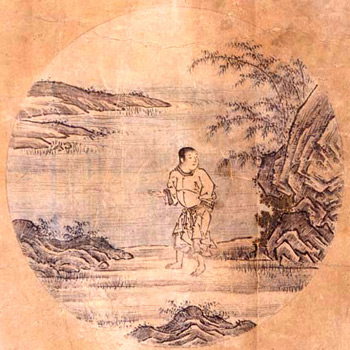
The beast has never gone astray, and what is the use of searching
for him? The reason why the oxherd is not on intimate terms with him
is because the oxherd himself has violated his own inmost nature. The
beast is lost, for the oxherd has himself been led out of the way
through his deluding senses. His home is receding farther away from
him, and byways and crossways are ever confused. Desire for gain and
fear of loss burn like fire; ideas of right and wrong shoot up like a
phalanx.
Alone in the wilderness, lost in the jungle, the boy is searching,
searching!
The swelling waters, the far-away mountains, and the
unending path;
Exhausted and in despair, he knows not where to
go,
He only hears the evening cicadas singing in the maple-woods.
II
Seeing the Traces
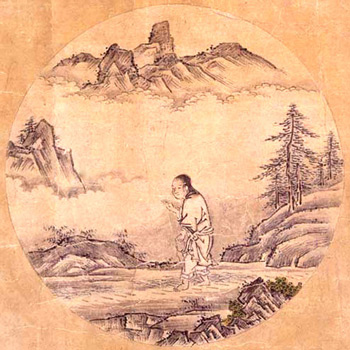
By the aid of the sutras and by inquiring into the doctrines, he
has come to understand something, he has found the traces. He now
knows that vessels, however varied, are all of gold, and that the
objective world is a reflection of the Self. Yet, he is unable to
distinguish what is good from what is not, his mind is still confused
as to truth and falsehood. As he has not yet entered the gate, he is
provisionally said to have noticed the traces.
By the stream and under the trees, scattered are the traces of the
lost;
The sweet-scented grasses are growing thick--did he find the
way?
However remote over the hills and far away the beast may
wander,
His nose reaches the heavens and none can conceal it.
III
Seeing the Ox
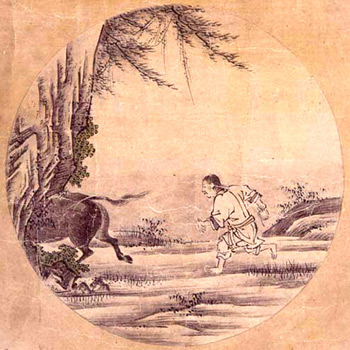
The boy finds the way by the sound he hears; he sees thereby into
the origin of things, and all his senses are in harmonious order. In
all his activities, it is manifestly present. It is like the salt in
water and the glue in color. [It is there, though not distinguishable
as an individual entity.] When the eye is properly directed, he will
find that it is no other than himself.
On a yonder branch perches a nightingale cheerfully singing;
The
sun is warm, and a soothing breeze blows, on the bank the willows are
green;
The ox is there all by himself, nowhere is he to hide
himself;
The splendid head decorated with stately horns what
painter can reproduce him?
IV
Catching the Ox
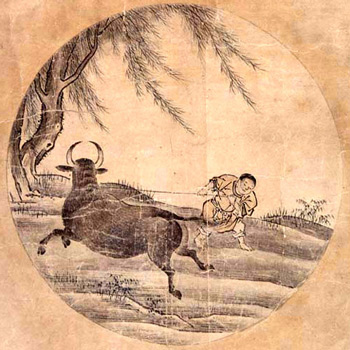
Long lost in the wilderness, the boy has at last found the ox and
his hands are on him. But, owing to the overwhelming pressure of the
outside world, the ox is hard to keep under control. He constantly
longs for the old sweet-scented field. The wild nature is still
unruly, and altogether refuses to be broken. If the oxherd wishes to
see the ox completely in harmony with himself, he has surely to use
the whip freely.
With the energy of his whole being, the boy has at last taken hold
of the ox:
But how wild his will, how ungovernable his power!
At
times he struts up a plateau,
When lo! he is lost again in a misty
unpenetrable mountain-pass.
V
Herding the Ox
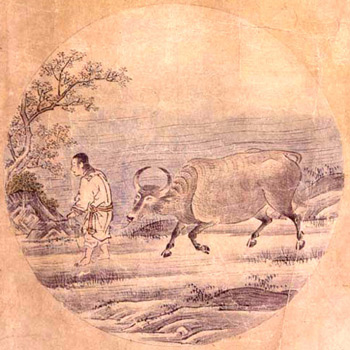
When a thought moves, another follows, and then another-an endless
train of thoughts is thus awakened. Through enlightenment all this
turns into truth; but falsehood asserts itself when confusion
prevails. Things oppress us not because of an objective world, but
because of a self-deceiving mind. Do not let the nose-string loose,
hold it tight, and allow no vacillation.
The boy is not to separate himself with his whip and tether,
Lest
the animal should wander away into a world of defilements;
When
the ox is properly tended to, he will grow pure and docile;
Without
a chain, nothing binding, he will by himself follow the oxherd.
VI
Coming Home on the Ox's Back
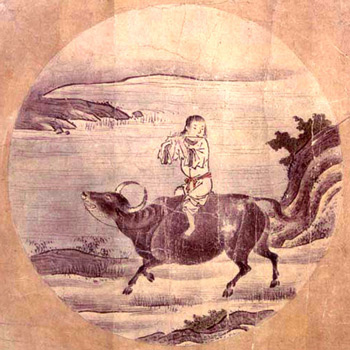
The struggle is over; the man is no more concerned with gain and
loss. He hums a rustic tune of the woodman, he sings simple songs of
the village-boy. Saddling himself on the ox's back, his eyes are
fixed on things not of the earth, earthy. Even if he is called, he
will not turn his head; however enticed he will no more be kept back.
Riding on the animal, he leisurely wends his way home:
Enveloped
in the evening mist, how tunefully the flute vanishes away!
Singing
a ditty, beating time, his heart is filled with a joy
indescribable!
That he is now one of those who know, need it be
told?
VII
The Ox Forgotten, Leaving the Man Alone
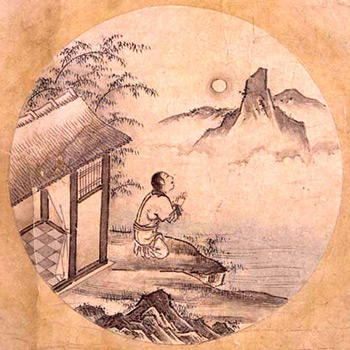
The dharmas are one and the ox is symbolic. When you know that
what you need is not the snare or set-net but the hare or fish, it is
like gold separated from the dross, it is like the moon rising out of
the clouds. The one ray of light serene and penetrating shines even
before days of creation.
Riding on the animal, he is at last back in his home,
Where lo!
the ox is no more; the man alone sits serenely.
Though the red sun
is high up in the sky, he is still quietly dreaming,
Under a
straw-thatched roof are his whip and rope idly lying.
VIII
The Ox and the Man Both Gone out of Sight
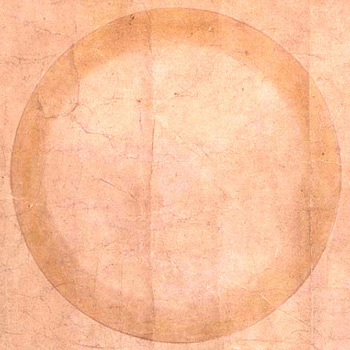
All confusion is set aside, and serenity alone prevails; even the
idea of holiness does not obtain. He does not linger about where the
Buddha is, and as to where there is no Buddha he speedily passes by.
When there exists no form of dualism, even a thousand-eyed one fails
to detect a loop-hole. A holiness before which birds offer flowers is
but a farce.
All is empty-the whip, the rope, the man, and the ox:
Who can
ever survey the vastness of heaven?
Over the furnace burning
ablaze, not a flake of snow can fall:
When this state of things
obtains, manifest is the spirit of the ancient master.
IX
Returning to the Origin, Back to the Source
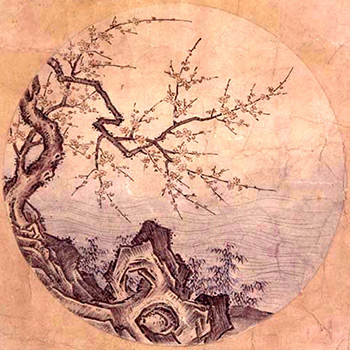
From the very beginning, pure and immaculate, the man has never
been affected by defilement. He watches the growth of things, while
himself abiding in the immovable serenity of nonassertion. He does
not identify himself with the maya-like transformations [that are
going on about him], nor has he any use of himself [which is
artificiality]. The waters are blue, the mountains are green; sitting
alone, he observes things undergoing changes.
To return to the Origin, to be back at the Source--already a false
step this!
Far better it is to stay at home, blind and deaf, and
without much ado;
Sitting in the hut, he takes no cognizance of
things outside,
Behold the streams flowing-whither nobody knows;
and the flowers vividly red-for whom are they?
X
Entering the City with Bliss-bestowing Hands
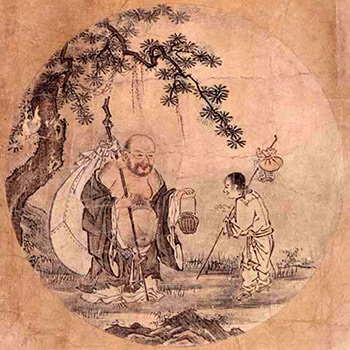
His thatched cottage gate is closed, and even the wisest know him
not. No glimpses of his inner life are to be caught; for he goes on
his own way without following the steps of the ancient sages.
Carrying a gourd [1] he goes out into the market,
leaning against a staff [2] he comes home. He is
found in company with wine-bibbers and butchers, he and they are all
converted into Buddhas.
Bare-chested and bare-footed, he comes out into the
market-place;
Daubed with mud and ashes, how broadly he
smiles!
There is no need for the miraculous power of the gods,
For
he touches, and lo! the dead trees are in full bloom.
1. Symbol of emptiness
(sunyata).
2. No extra property he
has, for he knows that the desire to possess is the curse of human
life.
PDF Files of the Ox Herding Pictures
Here are three different versions of the Ox Herding
pictures. Studying the different versions of the texts may
help to clarify and enrich the meaning of each step on the
path.
Version
1 - illustrations and text by Kakuan Shien, as
interpreted by D. T. Suzuki
Version 2 - illustrations by Tomikichiro Tokuriki, text
by Kakuan Shien, as interpreted by Paul Reps and Nyogen
Senzaki
Version 3 - illustrations by Tomikichiro Tokuriki, text
by Chögyam Trungpa
References
D. T. Suzuki, Manual of Zen Buddhism , Anchor
Books, 1956, Chapter VIII, p127
, Anchor
Books, 1956, Chapter VIII, p127
Paul Reps and Nyogen Senzaki,
Zen Flesh, Zen Bones , Tuttle and Co, 1957, p165
, Tuttle and Co, 1957, p165
Chögyam Trungpa , Mudra: Early Songs and Poems ,
Shambhala Publications, 1972, p73
,
Shambhala Publications, 1972, p73
Terebess web site ... a large
collection of ox-herding pictures and texts












